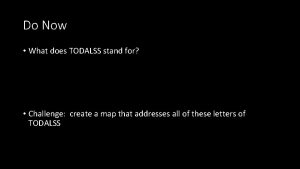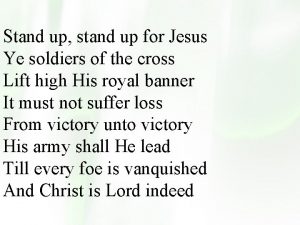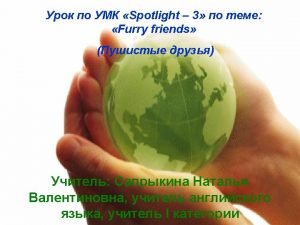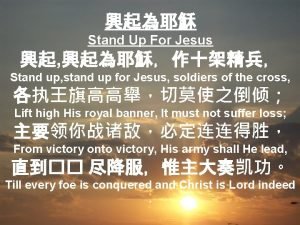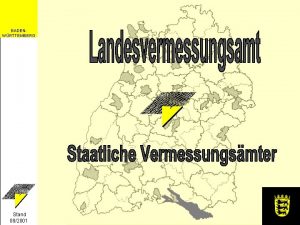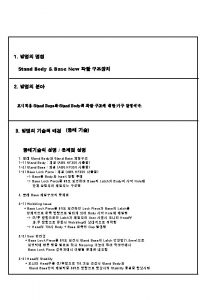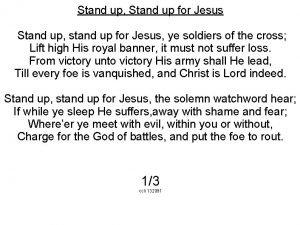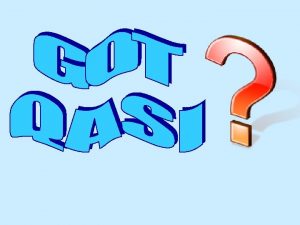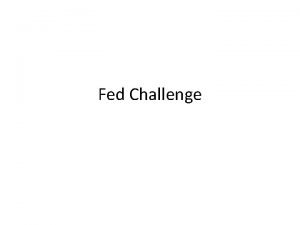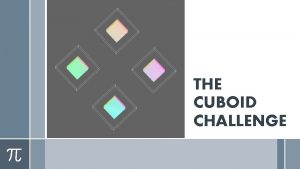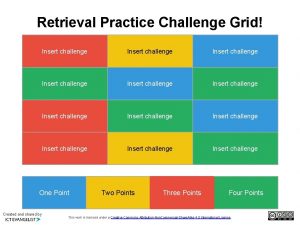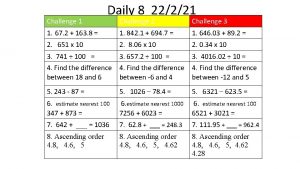Do Now What does TODALSS stand for Challenge













- Slides: 13

Do Now • What does TODALSS stand for? • Challenge: create a map that addresses all of these letters of TODALSS

Early People

The Land Bridge Story • The first people in North America thousands of years ago, are ancestors of present-day Native Americans, or American Indians. • Ancestor: an early family member • Scientists are still not sure of how the first people arrived in North America, but the have several theories. • Theory: an idea based on study and research. • One theory is that there was once a bridge called Beringia. It was named for the Bering Strait, the body of water that now separates Russia from Alaska. • Many scientists believe that thousands of years ago, there was several Ice Ages. During these long periods of freezing cold, slow moving sheets of ice called glaciers covered large parts of Earth.

A Long Journey • Many scientists believe that about 12, 000 years ago, groups of hunters and their families crossed the land bridge from Asia to North America. • Migration: movement of people or animals from one region to another.

Native American Origin Stories • Ideas about the presence of early people in the Americas also come from their decedents. • In Ancient times, most people passed on their history by retelling stories. • Native American groups have all used stories to tell about their past or how the world was made.

Early Ways of Life • Early people most likely led a nomadic way of life. They moved from place to place, living in caves or in tents made of animal skins. • They kept moving, following animals they hunted. • Scientists know this because they have found spear points and other artifacts near the bones of ancient animals. • Artifacts: an object made by a person

A Changing Way of Life • Giant animals, such as mastodons and woolly mammoths, once roamed North America. • They also gathered wild foods, such as nuts, plants, and roots. • Scientist refer to these people as hunters and gatherers. • About 3000 BC, some people in the Americas began planting seeds and growing crops such as corn and beans. • Agriculture, or farming, gave people a reason to settle in one place. • Some early people formed what are now called tribes, groups who shared the same language, land, and leaders.

The Olmec Civilization • Over time, groups began to form civilizations. • Civilizations: a group of people with ways of life, religion, and learning. • Some of these civilizations built large cities that became centers of learning, religion and government. • The Olmec civilization was one of the earliest in the Americas. From about 1500 BC to 300 AD, the Olmec ruled most of what is now southern Mexico. • Many Olmec cities were located near a river. • The Olmec used rivers to travel between cities and build a trade system.

The Olmec Civilization Continued… • Olmec artifacts have been found across Mexico. • A strong trade system was just one achievement of the Olmec. They also created systems of writing and counting. • These systems helped the Olmec develop a 365 day calendar. • No one is sure why the Olmec fell from power, but we know that they influenced other cultures. • Today, some historians call the Olmec the “mother culture” of the Americas.

The Mayan Civilization • The Mayan civilization was influenced by Olmec traditions. • Tradition: a way of life or an idea hand down from the past. • Between 300 AD and 900 AD, the Maya ruled much of what is now southern Mexico, Guatemala, and northern Belize • Like the Olmec, the Maya developed their own writing system. • This was based on hieroglyphs, or picture symbols. • The Maya were divided into social classes. • Class: a group of people in a society who have something in common.

The Mayan Civilization Continued… • At the top of Mayan society were the religious leaders then • important families • Traders • Farmers. • Mayan civilization had no central government, instead, powerful kings ruled cities and controlled the surrounding areas. • The Maya built more than 100 stone cities. • Scientist are not sure why the Mayan civilization fell. • Some scientist blame a series of droughts, however, even after the Maya fell from power, their cultural influence continued.

The Mound Builders • The Earliest Mound Builders were the Adena, they were located in the Ohio River valley. • 1000 BC to 200 AD • The Adena mounds were used for burials. • Some of the mounds reached heights of 90 feet! • The largest of the mound building civilizations was the Mississippian. • It began in the Mississippi River valley in about 700 AD. • By 1200 AD the Mississippi more than 30, 000 people lived in the city Cahokia, and helped support a strong trade system.

The Ancient Puebloans • The Ancient Puebloans lived in the area called Four Corners. • They lived in houses that had many levels. These houses were often built against canyon walls or in caves. • When the Spanish arrived in Southwest many years later, they called this kind of home a pueblo, the Spanish word “village. ”
 What does todalss stand for
What does todalss stand for Whitchester house
Whitchester house Now i see it now you don't
Now i see it now you don't Stand up for jesus
Stand up for jesus Nanny shine
Nanny shine Iso 22301 utbildning
Iso 22301 utbildning Typiska drag för en novell
Typiska drag för en novell Tack för att ni lyssnade bild
Tack för att ni lyssnade bild Ekologiskt fotavtryck
Ekologiskt fotavtryck Shingelfrisyren
Shingelfrisyren En lathund för arbete med kontinuitetshantering
En lathund för arbete med kontinuitetshantering Adressändring ideell förening
Adressändring ideell förening Vilotidsbok
Vilotidsbok A gastrica
A gastrica
